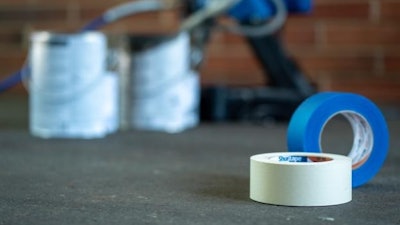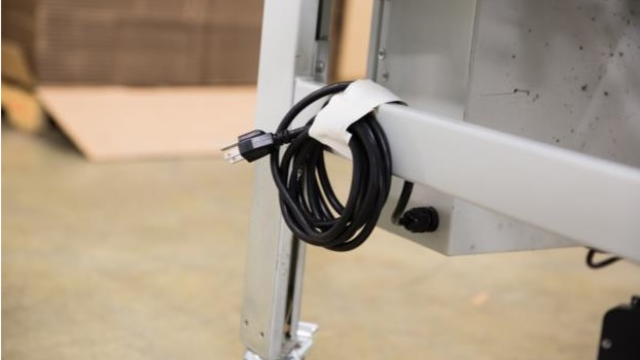
Tape looks like a simple tool with a singular task, but there’s more to it than simply sticking to surfaces. If you’ve been frustrated by paint seeping in under masking tape or the tape leaving behind a sticky mess when you removed it, chances are it was the wrong tape for the job.
Masking tape is a vital tool among general maintenance and construction personnel. But with so many types of masking tapes, even pros may get confused by the vast sea of products and end up using the wrong kind of tape for the task at hand. And that often simply comes down to awareness and education. Just as a screwdriver isn’t a substitute for a hammer, beige masking tape isn’t a substitute for blue painter’s tape, even though both are often referred to as masking tapes. Each is designed for different jobs and applications, and if used for the wrong task, you could end up wasting time on rework or removing and cleaning up unnecessary messes.
At a glance, a roll of beige masking tape and a roll of blue painter’s tape don’t appear very different from one another, with the exception of their respective colors. Both are typically constructed with a crepe paper backing, an adhesive layer and a release coat that allows the tape to peel off the roll. Both can also easily be torn by hand and have approximately the same texture and feel. All of these similarities place them in the same category of masking tape—which belies the significant differences in their intended use.  Shurtape
Shurtape
First and foremost, recall these general rules of thumb about usage: Beige masking tape, despite its name, is not intended for masking in painting applications—it has a stronger hold and is designed for general tasks like bundling and on-the-fly repairs. Conversely, blue painter’s tape has a less aggressive hold and is intended primarily for masking surfaces and producing clean lines in painting applications.
To help further clear up confusion and save you time on future jobs, let’s start by identifying problems associated with using the wrong tape and look at how to fix those problems with the right tape.
What Happens With the Wrong Tape
Masking tape problems often have less to do with tape quality and more to do with intended use. Some common signs that you’ve used blue painter’s tape when you should have used beige masking tape, or vice versa, include:
● Tape won’t adhere to a surface or material
● Paint seeps in under the tape, creating uneven lines
● Tape doesn’t maintain its bond with the surface or material, and it curls or peels
● Tape shreds when removing it from the surface
● Tape pulls off paint or finish when removed, causing surface damage and leading to repair work
● Tape doesn’t remove cleanly, leaving behind a sticky residue that requires cleanup
All of these issues result in inefficiencies that require time to remedy—and they take time away from getting to the next task on your list. The good news is that they can be avoided with a little understanding of which tape you need for different types of tasks.
Think Twice, Stick Once, Save Time
To remedy the undesirable effects of using the wrong masking tape on your project, let’s revisit some of the issues that arise from using the wrong type of tape and examine what characteristics make each kind of tape the right fit for common applications.
● When you need a tape that quickly sticks to repair work or to rough or uneven surfaces, you need higher tack. Tack is a term that describes how fast a tape’s adhesive sticks to a surface and creates a bond. The bond is how firmly the tape stays in place and how long it will securely remain there. For higher tack and a stronger bond, go with beige masking tape.
● To get clean lines when painting, reach for the blue painter’s tape. Yes, this is the obvious choice, but when painter’s tape isn’t handy, don’t make the mistake of using beige masking tape as a substitute for painting jobs. Painter’s tape is specifically designed for the task of painting, so it has a lower tack and lower bond strength to allow it to be pulled up and repositioned easily and so that it removes cleanly without damaging existing paint or finishes. Its paper backing also tends to more easily flex and stretch around angles and curves and inconsistent surfaces, making it ideal for painting around objects like molding.
● Curling and peeling can be caused by low tack and temperature fluctuations that lead to poor adhesion and a weak bond. For tape with a higher tack that delivers a stronger bond and prevents curling and peeling in a higher range of temperatures, grab a roll of beige masking tape.
● Shredding—when tape tears off in little pieces upon removal—typically happens when you try to remove beige masking tape from a surface with which it has formed a strong bond. To avoid shredding, try blue painter’s tape. Painter’s tape has a lower bond strength that is intended to release easily.
● Sticky residue is most often associated with beige masking tapes that have been exposed to high temperatures, as extreme heat can cause the adhesive to separate from the crepe paper backing, leaving the adhesive behind. When working in hot conditions where you need masking tape to make a repair, you can prevent sticky residue by choosing a beige masking tape rated for higher temperatures.
These tips are a general guide for maintenance and construction personnel who want to make better tape choices for everyday tasks that will save time and prevent rework. Keep in mind, masking tapes can also be highly specialized tools, so if you have a specific task that does not fit into these guidelines, ask your supplier to recommend the best masking tape for your needs.
Tips for More Creative Uses of Masking Tapes
Over the years, maintenance and construction personnel have found creative new ways to use masking tapes that go beyond painting and repairs. Like traditional uses of tape, these added uses rely on choosing the right tape for the job. Here are some tape tricks that may help you work smarter and more efficiently at your shop or worksite.
Directing traffic: Masking tape is a quick and easy way to place arrows on walls or floors to direct people through a busy worksite or lead people to a specific location. Blue painter’s tape is the best choice for this use as it will remove easily from walls and floors without removing paint or finishes.
Labeling tools and supplies: Tool and supply labeling for different work crews or different uses can save time and keep work areas organized. Since labeling is likely to be left in place for a long period of time, beige masking tape works best.
 ShurtapeBundling cords: Masking tape can help you keep long power cords out of the way or ropes wrapped up. For longer-term bundling, use beige masking tape. For temporary bundling, use blue painter’s tape.
ShurtapeBundling cords: Masking tape can help you keep long power cords out of the way or ropes wrapped up. For longer-term bundling, use beige masking tape. For temporary bundling, use blue painter’s tape.
Color-coding: While we tend to think of masking tape in the classic beige color, it also comes in a variety of other colors that make it a great choice for color-coding tools, supplies and materials. Color-coding is an effective way to instantly communicate how or where something is to be used or who it belongs to.
A Little Knowledge Goes a Long Way
Arming yourself with a better understanding of the main differences between beige and blue masking tapes can help inform your purchasing and application decisions. When you know what type of tape to use for different kinds of tasks, your tape will deliver better results and save you time and effort on the job.
Patti LaPorte is the Director of Product Marketing, Painter’s Tapes, for Shurtape Technologies, LLC. For more information, visit www.shurtape.com.























